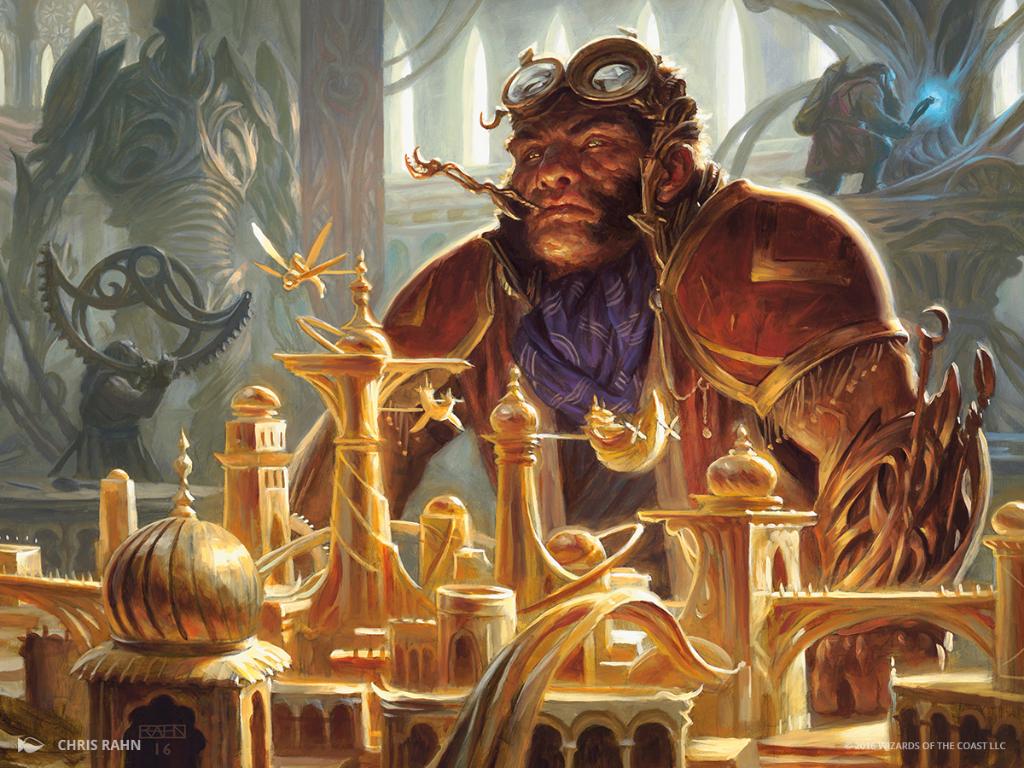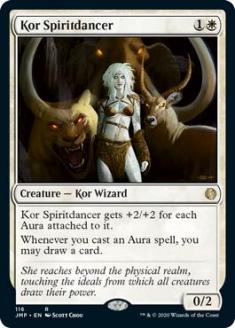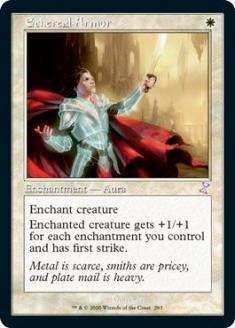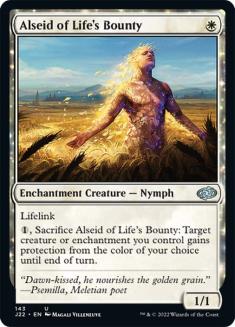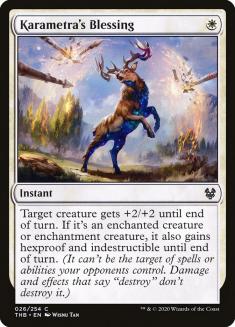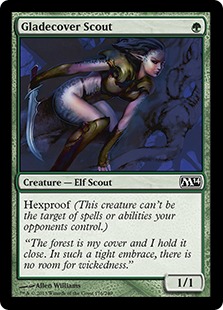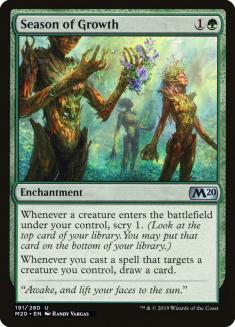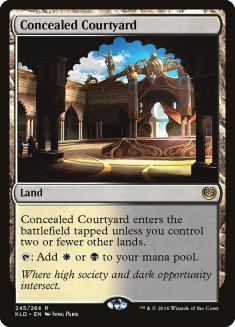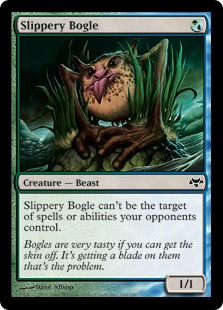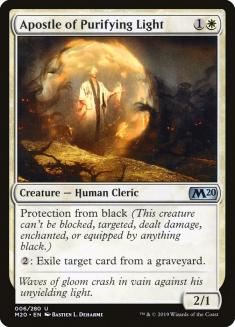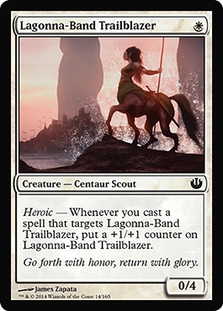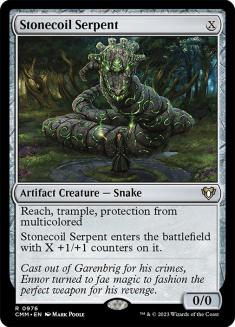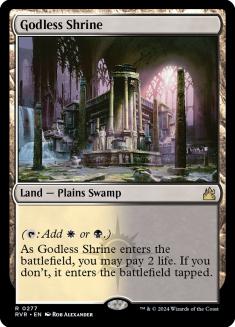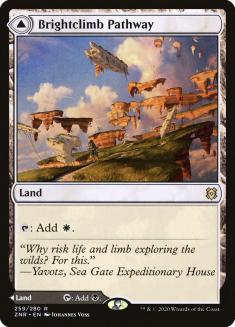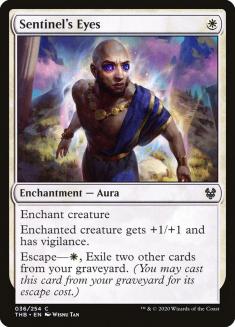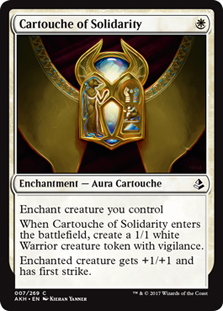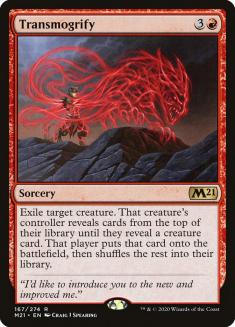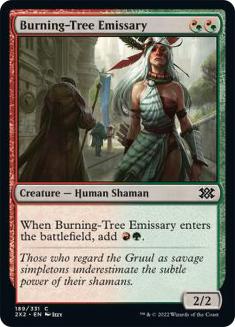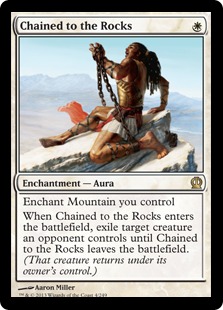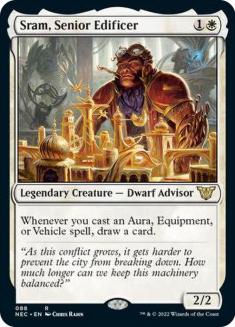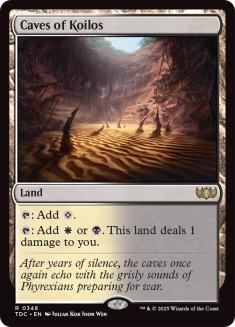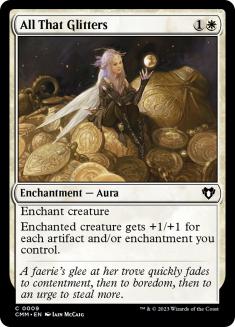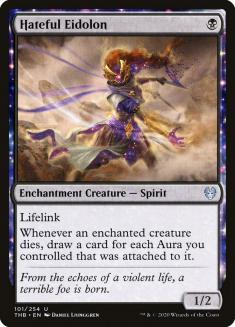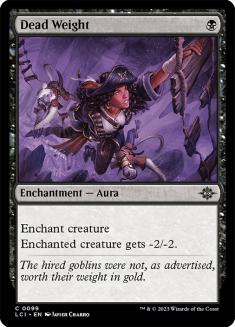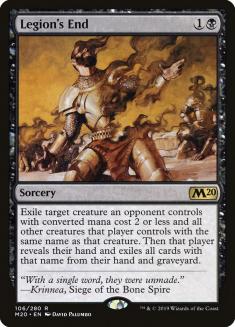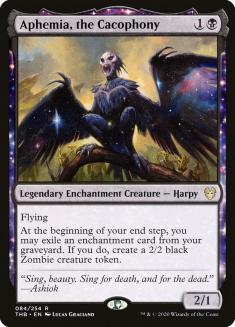Right after the giant ban refresh in Pioneer last month, I called out Orzhov Auras (Lurrus) as an exciting new prospect in a post-Teferi, Time Raveler world.
Creatures (18)
- 2 Lagonna-Band Trailblazer
- 4 Sram, Senior Edificer
- 2 Apostle of Purifying Light
- 2 Stonecoil Serpent
- 4 Alseid of Life's Bounty
- 4 Hateful Eidolon
Lands (20)
Spells (22)

And here it is, winning one of the highest-profile Pioneer events since then among many other solid finishes. This isn’t some one-hit wonder exploiting a specific metagame either. Orzhov Auras is extremely fast, consistent, and much more resilient than you would assume at first glance.
What Orzhov Auras Is Doing
Creatures (13)
Lands (18)
Spells (29)

I’m also a fan of Orzhov Auras in Historic, but I quickly found out the Pioneer build of the deck is doing a completely different thing despite sharing a lot of cards and a name.
This is largely driven by the best cards in each deck that aren’t legal in the other format: Kor Spiritdancer in Historic and Ethereal Armor in Pioneer.
The Historic deck has eight creatures that draw cards on Aura casts, and importantly Kor Spiritdancer is non-legendary so you can control multiples, while the Pioneer deck is limited to a single Sram, Senior Edificer at a time. Spiritdancer also lets you convert any random Aura into significant amounts of power, so you’re less concerned with your Auras doing that by default.
The Historic Orzhov Auras deck is aiming to protect and stack multiple card draw engines, at which point you just sorta take arbitrary game actions and bury your opponent in cardboard. Things like Thoughtseize that force exchanges are great. Kaya’s Ghostform is great since, as long as your creatures stick around, you’ll be overloaded on Auras to rebuild with, and you can short yourself on All That Glitters since you only need them to push through a lethal attack some of the time.
The Pioneer deck has Ethereal Armor instead, which is a huge amount of power for one mana. This pushes Pioneer Orzhov Auras closer to Modern Selesnya Hexproof than Historic Orzhov Auras. You’re just getting your opponents dead as quickly as possible. You want all your cards to be more Auras that stick on the battlefield, you want the hardest-to-kill targets for them, and you want them to be as efficient as possible.
The stacks of lifelink creatures win races against all the monocolored aggro decks of Pioneer. You want Karametra’s Blessing over Kaya’s Ghostform because losing all the other Auras on a creature is a significant setback, and sometimes +2/+2 is just lethal. Gryff’s Boon is another huge addition, often letting you one-shot people with stacked Ethereal Armors and All That Glitters.
You might notice the Pioneer Orzhov Auras maindeck is almost completely mono-white since you aren’t leaning on the black cards to trade off and leverage card advantage. People have dabbled with Selesnya and Azorius Auras lists, but there are two issues.
- Thoughtseize is still stupidly good. It takes the thing you want every time and lets you tap mana up front.
- Neither deck has Concealed Courtyard or Caves of Koilos. They have Mana Confluence and sadness.
Orzhov Auras just has better sideboard cards and better mana. Gladecover Scout can get another try when Razorverge Thicket hits Pioneer.
Playing Around Things Some of the Time
While Orzhov Auras is kinda like Selesnya Hexproof in pace of play, your creatures aren’t really like the ones in Selesnya Hexproof. They literally don’t have hexproof, and your opponents won’t show up with zero kill spells. You’ll have to play around your opponent doing things some of the time.
A lot of playing around removal with this deck starts by putting Auras on creatures that don’t die to removal. Mono-Black Aggro, various Mono-Red Aggro decks, and Five-Color Niv-Mizzet will try to overload you with removal, but you have coverage down the line there with Apostle of Purifying Light, Lagonna-Band Trailblazer (four toughness is basically protection from red), and Stonecoil Serpent.
You have ways to directly protect your creatures from removal, but they involve leaving up mana and cutting into deploying Auras and threatening a clock. Some lists do play a couple of copies of Selfless Savior in the Lagonna-Band Elder slot to help avoid this issue, which I don’t have a strong preference for or against. Whether you play it slow and safe or just YOLO is always a tough decision, but I have a few heuristics that can help out.
If my hand already has three or four lands, I tend to play it safe. If you’re going to hit three or four mana, your Auras are cheap enough and add up quickly enough that you can usually sit on a piece of one-mana interaction.
The hands with less lands tend to have more bodies and filler Auras, which is the other thing I look for as a reason to take a risk. Usually the pattern here is to drop some small threat, throw a couple of low-quality Auras on it at risk to get some power on the battlefield, and then if it lives you can decide whether to shove with Ethereal Armors or if a few damage this turn and setting up defenses is better. Having Hateful Eidolon as that first creature is another push towards this plan against non-exile removal, since it just refunds your cards if it dies to Fatal Push.
The other reason to take a risk is if your opponent is playing a deck with some giant end-game you need to race. Right now, this is most common against Four-Color Fires (Yorion), but plenty of other decks could fit this paradigm.
You also just have a bunch of naturally recursive resources that can power through removal. You usually can’t deal the full twenty off these small rebuys unless Lurrus of the Dream-Den lives for several turns, but if you can get your opponent into single digits with one good Ethereal Armor hit, a Gryff’s Boon can close out the game.
Alseid of Life’s Bounty also lets you sneak a creature through blockers, but there’s one huge gotcha with the card. Giving a creature protection from white with Alseid of Life’s Bounty usually ends poorly. You keep the creature, but all your white Auras fall off. Oops.
I’m not super picky about waiting to cast Sram until I can get a cantrip out of following it up with an Aura. Usually it immediately dying to removal is good enough since it means I get to suit up something else.
If I do get to casting Auras while I control Sram, I’ll try to suit up a creature that isn’t Sram if given the chance. Pretty basic stuff: Sram is a high-priority target to answer even as a 2/2, while your random other creature might not be unless you put Auras on it. The exception here involves having Hateful Eidolon, Sram, and a third creature that’s going to wear all the large Auras, in which case you can spread some low-value Auras around to make everything a bad target for removal.
Mulligans
Creatures, Auras, lands. If a hand has all three pieces, I’m keeping it unless it’s all Plains and Hateful Eidolons.
Hands with no creatures are obviously not going to happen. Ship it since Lurrus as your first body is too slow.
Hands with creatures but no Auras aren’t great, but if one of those creatures is Sram I usually feel comfortable being able to chain my way out of it with a single Aura draw.
If you know a specific creature is great in the matchup and you have it, I would also keep. This rule is mostly “Don’t mulligan hands that cast Apostle of Purifying Light against Mono-Black Aggro.”
One-land hands are sketchy but I’m willing to keep them in a few scenarios. They need a one-drop creature and multiple one-mana Auras (preferably Ethereal Armor). The land also can’t be a concern. Usually that is Brightclimb Pathway plus Hateful Eidolon not working out with the rest of your deck being white, but sometimes it’s that using Caves of Koilos every turn is a liability in the matchup.
When you sideboard in Dead Weight, Hateful Eidolon plus Dead Weight with a good land is another easy one-land keep. You draw a free card and do the thing you sideboard to do, easy.
Thoughtseize in this deck is just temporarily punching a hole in a plan and giving you time, which you immediately give back if you don’t draw a land. Don’t change your mulligan strategies much when you sideboard that card in unless your opponent is some true glass cannon deck like Tibalt’s Trickery.
On six cards, most one-land hands with a one-drop, a land that casts it, and some solid Auras are good enough for me. Card density does really matter for this deck since your key Auras are all about counting.
Matchup and Sideboarding Guide
VS Five-Color Niv-Mizzet
Creatures (16)
- 4 Sylvan Caryatid
- 1 The Scarab God
- 1 Hostage Taker
- 1 Deputy of Detention
- 3 Niv-Mizzet Reborn
- 1 Faeburrow Elder
- 1 Klothys, God of Destiny
- 2 Omnath, Locus of Creation
- 2 Valki, God of Lies
Planeswalkers (1)
Lands (27)
Spells (16)

The key understanding of the Five-Color Niv-Mizzet matchup is that your opponent has answers, but they’re kinda clunky and kinda limited. You’re going to want to bias towards protecting your setups over going for it and hoping to dodge removal. There’s a bit of urgency in this matchup since your opponent has powerful late-game plays to wrap up, but those plays aren’t 100% game-ending. They do have Bring to Light for Extinction Event, which none of your protective spells stop.
Also, understand how to draw Stonecoil Serpent or Apostle of Purifying Light, which honestly might be better since it dodges Abrupt Decay and all the multicolor black removal.
Out:
In:
This might be one creature too many coming out, or one Thoughtseize too many coming in, but you want all these cards to mitigate their interaction while staying as aggressive as possible. You notably don’t want Aphemia, the Cacophony because you don’t want to fight them by running them out of removal, because that just leads to them casting Niv-Mizzet Reborn instead and having a million cards to win with.
While I don’t mind the Five-Color Niv-Mizzet matchup, the other five-color deck is a complete nightmare. If people start switching over to Five-Color Enigmatic Incarnation, that would scare me off Orzhov Auras. Trial of Ambition is a giant jerk. If you really want to beat Orzhov Auras, look for cards which will remove a creature without targeting or destroying it. Thing in the Ice, Settle the Wreckage, and Extinction Event are some of the other good ones.
VS Rakdos Arcanist (Lurrus)
Creatures (16)
Lands (23)
Spells (21)

The current Rakdos Arcanist lists are short on Claim the Firstborn, which is a big deal for Orzhov Auras. That means you can ride an Apostle of Purifying Light to victory, including using it to clear out Kroxa, Titan of Death’s Hunger before it can escape or in combat after it gets blocked by a giant vigilance Apostle. If you don’t have an Apostle, you’re just trying to catch their removal with some kind of protection or grind them down. Your opponent’s plan usually involves getting a Young Pyromancer or Dreadhorde Arcanist going, which makes Gryff’s Boon to fly over Elemental tokens key.
Out:
In:
First thing here: their removal all costs one, so I’m avoiding things that involve losing those exchanges on mana. Aphemia counts because the Zombie it leaves behind doesn’t beat either of the red creatures in combat, and All That Glitters is another. They often deal a lot of damage to themselves with Thoughtseize and Blood Crypt, so you don’t need the biggest thing ever to kill them, and All That Glitters just leaves you tapped out and exposed a lot.
Second: you really want to kill Young Pyromancer and Dreadhorde Arcanist. Without those cards their deck doesn’t pull ahead on attrition, and Dead Weight basically kills both of them since a -1/1 Dreadhorde Arcanist doesn’t do much.
Watch out for Angrath’s Rampage. You can’t always keep a creature around, but if you have an Apostle on the battlefield, prioritize backing it up with a Cartouche of Solidarity token or really anything.
VS Mono-Black Aggro
Creatures (26)
- 3 Bloodsoaked Champion
- 2 Kalitas, Traitor of Ghet
- 4 Scrapheap Scrounger
- 4 Dread Wanderer
- 2 Spawn of Mayhem
- 4 Knight of the Ebon Legion
- 3 Rankle, Master of Pranks
- 4 Murderous Rider
Lands (25)
Spells (9)

This matchup always feels a bit scary, since they have a clock and removal, and then suddenly everything they tried to do falls apart and they die. Again, playing with Apostle, aka True-Name Nemesis that Mutavault can block, might have something to do with this, but Lurrus also plays a huge role. Even if they Thoughtseize an Apostle, you can pick up Lurrus and cast it into Apostle at five mana. You can’t always do it because they attack your resources hard, but watch out for Rankle, Master of Pranks.
Out:
In:
Dead Weight is pretty bad against all the recursive threats here, and you only want a bit of removal to keep them from killing you and casting removal at the same time. I like Karametra’s Blessing, but there’s an issue with too many in a matchup where they’re coming for all of your resources at once. Aphemia is solid here since the Zombie tokens matter in combat against the dorky Mono-Black Aggro creatures, and black creatures are kinda nice if your opponent shows up with Self-Inflicted Wound.
VS Mono-Green Devotion/Aggro
Creatures (25)
- 4 Llanowar Elves
- 4 Burning-Tree Emissary
- 4 Elvish Mystic
- 2 Genesis Hydra
- 4 Jadelight Ranger
- 4 Voracious Hydra
- 3 Vorinclex, Monstrous Raider
Planeswalkers (9)
Lands (20)
Spells (6)

You aren’t seeing as much Mono-Green these days in Pioneer tournament results, and I would bet some of that has to do with the Orzhov Auras matchup. You just eventually make a 20/20 flying or protection from green lifelink thing and kill them, and there isn’t much they can do about it.
The very short list of things to watch out for: Nissa, Who Shakes the World makes colorless land Elementals, so don’t try to Alseid of Life’s Bounty your way through them; think about how big of a Voracious Hydra they can make early on when sizing up your plays; and don’t let them -5 Vivien, Arkbow Ranger.
Out:
In:
It gets even worse for them after sideboarding somehow because Dead Weight is so good against them. Again, they really can’t kill Sram or Hateful Eidolon, so beyond just killing their Llanowar Elves, you often get to draw a card while doing it.
I like a bit of Aphemia here because flying is so key. The one scary thing they can do is Back to Nature, which is shockingly beatable because the rest of their deck is so bad against yours, but if you see that card you might want to swap the Aphemias back for the Cartouche of Solidarity and Karametra’s Blessing rather than lean on more enchantment creatures. Again, thankfully Dead Weight means you’re drawing even more cards and leaving even fewer things on the battlefield.
VS Four-Color Fires (Yorion)
Creatures (3)
Planeswalkers (6)
Lands (34)
Spells (37)

The thing I always think about playing this matchup is how you can sense the disappointment through Magic Online (MTGO) when your opponent taps out to set up a Transmogrify the next turn and then just dies to another Ethereal Armor. This really is a race with a bit of tactical safety, and while your opponent has answers, few of them are instants and they need to tap mana to produce a creature or Fires of Invention to get into position to do anything big.
Out:
In:
You really are approaching this matchup like you approach a combo matchup. This is exactly how you sideboard against Lotus Field Combo, and the result is probably a bit better for you. I’ve had Lotus Field opponents be real jerks with tons of Blink of an Eye and Blast Zone, where most Four-Color Fires (Yorion) decks are less effective at sideboarding due to 80 cards and The Raven’s Warning. I don’t have any specific Thoughtseize timing to share since they have plays all the way up that matter. Just fire it off and take the right card.
My results with Orzhov Auras (Lurrus) have been really solid. I’ve made the comparison to Modern Selesnya Hexproof a lot, but the big difference between those decks is Pioneer Orzhov Auras feels more resilient. At least until a big shift in the format happens that naturally crushes Orzhov Auras out of the metagame, I expect to see it putting up numbers and remaining a solid choice in the week-to-week metagame cycle.

